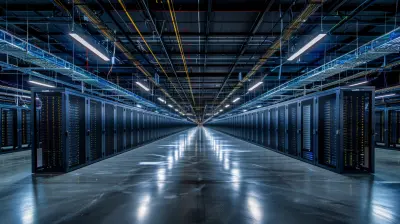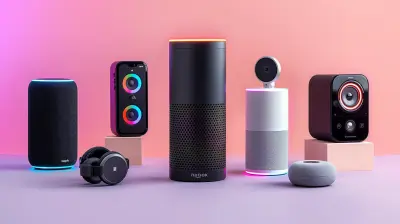Edge Computing: Bringing Cloud Power Closer to You
9 October 2025
Let’s be real—technology is evolving faster than our coffee gets cold. And just when we thought cloud computing was the future, along comes something even more exciting. Say hello to edge computing—the fast-moving, game-changing tech that’s flipping the script on how we handle data.
If you're wondering what all the fuss is about or why your smartphone might soon be benefiting from supercharged cloud-like power, buckle in. We’re diving deep into how edge computing is quietly revolutionizing our digital lives, one device at a time.
Wait, What Exactly Is Edge Computing?
Imagine this: you're about to stream a movie on your favorite app, but there's an annoying delay—and it’s not your Wi-Fi. That data request has to travel all the way to a remote data center, wait in line like it's buying concert tickets, then shuffle back to you. That’s traditional cloud computing.Now imagine the data getting processed almost instantly—right there, near you, as if your device had a supercomputer attached. That’s edge computing.
In simple terms, edge computing brings computation and data storage closer to where it's actually needed—whether that’s your phone, your car, a smart camera, or even a vending machine. Instead of sending everything to a faraway data center, edge computing handles it locally. Fast, efficient, and super smart.
Why Should You Care About Edge Computing?
Let’s face it: We live in a world of instant gratification. We hate lag, delays, and buffering more than a Monday morning. Edge computing is all about speed, responsiveness, and real-time access to data.Here are a few real-world reasons this matters:
✅ Ultra-Low Latency
In tech speak, latency is just a fancy word for delay. With edge computing, data doesn’t have to travel across the country—or worse, across the globe—to get processed. That means things like real-time gaming, augmented reality, and autonomous vehicles can actually work without hiccups.Imagine a self-driving car sending its collision alerts to a cloud server on the other side of the world. That split-second delay could mean disaster. With edge computing, the processing happens locally—like having a quick-thinking co-pilot right there with you.
✅ Reduced Bandwidth Usage
Let’s use a little analogy. Picture the entire internet as a highway. The more data we send to central cloud servers, the more congested that highway becomes. Edge computing acts like building extra service roads closer to your neighborhood, easing the traffic and keeping things flowing smoothly.This reduction in data transfer also means lower costs and fewer bottlenecks, especially in industries drowning in data like video surveillance or smart manufacturing.
✅ Increased Reliability
Ever had your smart assistant glitch out because your internet dropped for two seconds? With edge computing, devices can still process essential functions locally, even if they lose connection to the cloud. Think of it as technology with a built-in backup generator.
So, Where Is Edge Computing Showing Up?
You’re probably already using edge computing without even realizing it. This isn’t just some tech buzzword—it's becoming part of our daily lives.🏠 Smart Homes
From your smart thermostat adjusting temperatures, to your video doorbell recognizing your delivery guy—devices in smart homes are starting to do more of the ‘thinking’ locally. That means faster responses, better privacy, and less dependency on the internet.🚗 Autonomous Vehicles
Cars today are basically mobile computers—sensors, cameras, GPS, you name it. Edge computing allows all that hardware to work together in real-time, helping the vehicle make instant decisions. No cloud processing time. No data delay. Just fast, reactive intelligence on wheels.🏭 Industrial Automation
Factories are now decked out with smart sensors and machines churning out mountains of data. Edge computing lets manufacturers process that data on or near the shop floor instead of sending it all to a central server. That means less downtime and quicker fixes when something goes sideways.📱 Mobile Devices and AR/VR
Ever used Snapchat filters or tried out a VR headset? That kind of fast image processing requires real-time feedback—something edge computing excels at. Mobile apps are slowly beginning to lean on edge for better performance and smoother user experiences.
The Tech Behind the Curtain: How Edge Computing Works
Let’s sprinkle in a little behind-the-scenes magic—without the jargon.🧠 Edge Devices
These are the frontlines of edge computing. They include anything from your smartphone to IoT devices, robots, and smart cameras. Edge devices gather and sometimes analyze the data before sending it elsewhere—if needed.🏢 Edge Servers
Think of these like mini-data centers that are much closer to you than traditional cloud servers. They act as the middle layer between devices and the big cloud providers, doing the heavy lifting closer to home.☁️ Cloud Integration
Here’s the cool part—edge computing doesn’t replace the cloud; it complements it. It handles time-critical tasks locally, while sending less urgent data to the cloud for storage, deeper analysis, or long-term patterns. It’s a tag-team duo that boosts productivity and performance.The Benefits? They’re Kind of Mind-Blowing
🔐 Improved Privacy and Security
When sensitive data is processed closer to its origin, you reduce exposure to potential cyberattacks during transmission. Plus, not having to send everything to centralized cloud storage means users maintain more control.⚡ Efficiency and Speed
Faster processing means less power consumption, quicker decision-making, and smoother workflows. Every industry from healthcare to agriculture is starting to benefit.🌍 Scalability
Deploying edge solutions lets businesses scale operations without always expanding cloud infrastructure. Think about hundreds of connected devices in a smart city—edge computing allows them to function independently while still being part of the bigger picture.Real-World Use Cases: It’s Already Here
Edge computing isn’t just a theory—it’s already powering everything from life-saving tech to your go-to weekend entertainment.🏥 Healthcare
Wearables that monitor heart rates, glucose levels, or sleep patterns can now process health data in real-time, alerting caregivers or users instantly if something’s wrong.⚽ Sports and Entertainment
Stadiums are using edge analytics to enhance fan experiences—like providing instant replays or interactive features directly to your phone, without delay.🌆 Smart Cities
From managing traffic lights to monitoring air quality, smart cities are relying on edge computing to make data-driven decisions fast without overloading central systems.The Challenges: It’s Not All Sunshine and Rainbows
Okay, let’s pump the brakes for a second. Edge computing isn’t perfect (yet).🛠 Infrastructure Investment
Setting up local edge servers and upgrading devices can be expensive. It’s more than just plugging in a smart speaker and calling it a day.🔐 Security Complexity
With more devices handling sensitive data, there’s a bigger attack surface. Securing all those endpoints? That’s a lot on IT's plate.🔄 Data Synchronization
Making sure local data gets accurately synced with the cloud—and vice versa—can get tricky. It’s like trying to keep multiple spinning plates balanced in the air at once.But like any evolving technology, these are growing pains. With innovation and smart planning, many of these hurdles are already being tackled head-on.
The Future of Edge Computing: Where Are We Headed?
Let’s dream a little.🚀 AI at the Edge
Artificial Intelligence is becoming edge computing’s best friend. Imagine cameras that don’t just record but analyze footage right away. Or smartphones that adapt in real-time based on how you're using them. The combo of AI and edge is turning ordinary devices into intelligent co-pilots.🛰 5G + Edge = A Match Made in Tech Heaven
The rollout of 5G networks means faster connectivity and more devices online than ever before. When you mix 5G with edge computing, it’s like giving wings to an already powerful jet. Together, they’re building the foundation for smart cities, real-time remote surgeries, and beyond.🧬 Personalized Everything
From entertainment to medicine, edge computing allows hyper-personalized experiences. Your fitness tracker could offer real-time health recommendations tailored only to you. Your car might adjust comfort settings the moment you sit in. It's like technology that knows you better than your best friend.Final Thoughts: The Edge Is Just the Beginning
Edge computing isn’t just a buzzword—it’s a shift. A shift that brings cloud-like power closer to where we live, work, and play. It's about immediacy, intelligence, and innovation all packed into devices that sit right in your pocket or home.As we continue to demand faster, smarter, and more secure technology, edge computing will step up, quietly running in the background but making a massive difference.
It’s not replacing the cloud; it’s making it better. And whether you're a techie, a business owner, or just someone who loves having everything lightning-fast, edge computing is going to be part of your world sooner than you think.
So next time your smart speaker answers instantly or your video doorbell shows you footage in real-time, remember—there’s a little edge magic at play.
all images in this post were generated using AI tools
Category:
Future TechAuthor:

Reese McQuillan
Discussion
rate this article
1 comments
Lucas McWhorter
Exciting insights on edge computing! It's fascinating how this technology can enhance performance and reduce latency. Can't wait to see its real-world applications evolve!
October 9, 2025 at 2:46 AM

Reese McQuillan
Thank you! I'm glad you found the insights exciting. The real-world applications of edge computing are indeed on the horizon, and it will be thrilling to see how they evolve!


